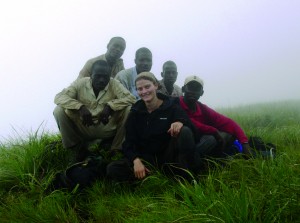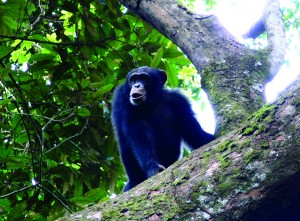MONDAY, 4 JANUARY 2010
I first set foot on African soil as an undergraduate ready for a life-changing experience as I headed into the tropical rainforests of western Africa to study the elusive chimpanzees of the Nimba Mountains in southwest Guinea. Little did I know that six years later, I would have spent the equivalent of two and a half years roaming the Nimba forests and have chosen to focus my PhD on the elementary technology used by chimpanzees.Elementary technology refers to the use of tools, for example in foraging. Chimpanzees across Africa vary greatly in the types of tools they use to obtain food. Some groups use stones to crack open nuts, whereas others use twigs to fish for termites. Chimpanzees, like humans, have distinct local cultures that use different types of technology. My research partly tackles the question of how these cultures evolve.
Chimpanzees also use technology for ends other than foraging. All wild chimpanzees build their nests (or beds) in the trees every night by breaking and weaving branches into a sleeping platform. But what is the function of nest building? And why do chimpanzees in Nimba also build nests on the ground? I’m addressing these questions by measuring the environmental factors that influence a chimpanzee’s choice of sleeping location, including climatic conditions, insect densities and nest tree properties.
Studying chimpanzee technology can be challenging because your subjects tend to run away as soon as they spot you. It takes years of persistence and hard work before wild chimpanzees will accept the presence of humans. Each month, I spend 20 days with a team of dedicated local trackers in a small camp at the heart of the forest, hours from the nearest village. My average work day entails ten hours of trudging through mud and negotiating rocky slopes while searching for chimpanzees. The days can feel long and hard, especially at the peak of the rainy season when there are daily torrential downpours.
However, wet clothes and tired muscles are instantly forgotten when we encounter the chimpanzees. The first time a young male tolerated our presence and came down from a tree to investigate us was unforgettable. Initially, he was torn between fear and curiosity, approaching but screaming at the same time. Curiosity won over. After the initial excitement, he calmed down and took a nap only ten metres away.
Even if a direct sighting is not possible, information can be gleaned by other methods. Chimpanzees move around in search of food, leaving behind their tools and nests. These provide a wealth of information. In addition, ecological factors, such as the availability of food (including fruits and insects) can be systematically measured and analysed. It is even possible to obtain information about nest-builders without ever seeing a chimpanzee, for example by collecting hairs from nests and analysing the DNA.
Chimpanzees are our closest living relatives and can provide invaluable insights into our own evolutionary history. By unravelling the factors that drive the use of technology by chimpanzees, we may shed light on how and why Homo sapiens became so dependent on tools. However, chimpanzees are critically endangered and have disappeared from numerous countries across Africa. Only urgent efforts will ensure that they don’t disappear before we learn more about them.
Kathelijne Koops is a PhD student in the Department of Biological Anthropology


